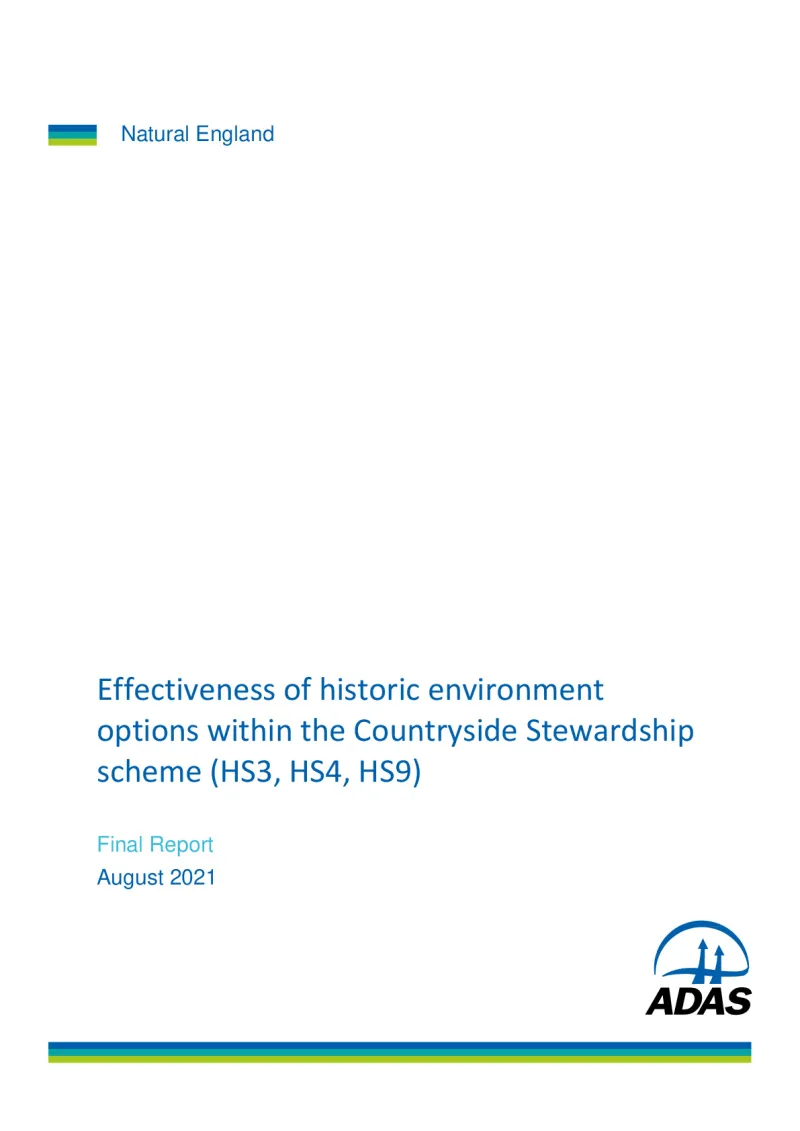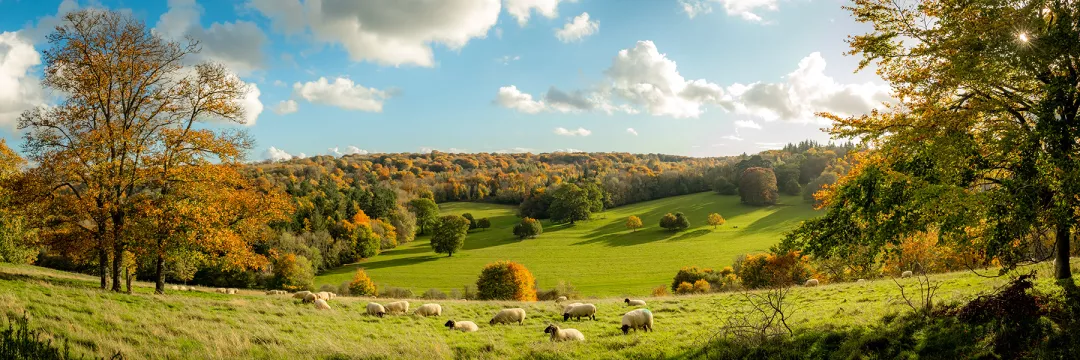Effectiveness of historic environment options within the Countryside Stewardship scheme
The report evaluates the effectiveness of three historic environment options within the Countryside Stewardship scheme that have low uptake.
- Other
- 2014-2022
- Environmental impacts


The aim of this report, commissioned by Natural England, is to assess the effectiveness of three historic environment (HE) options within the Countryside Stewardship (CS) scheme that have low uptake. The historic environment options are Historical Site (HS) 3 (reduced-depth, non-inversion cultivation on historical and archaeological features), HS4 (scrub control on historical and archaeological features) and HS9 (restricted depth crop establishment to protect archaeology under an arable rotation). This review evaluates option deployment trends to understand where and why the options have been used, to gather evidence as to why options have not been selected and to suggest ways the options could be improved, promoted or targeted more effectively.
The study was developed as follows. First, an analysis of data, including Agri-Environment Scheme uptake data, Heritage at Risk (HAR) data, Rural Payments Agency's CropMap and satellite data.
Then, it followed an online survey of farm managers who omitted options HS3, HS4 and HS9 from their applications to understand low option uptake in areas where it is most needed. In addition, a telephone survey of agreement holders who used options HS3, HS4 and HS9 (both on and off scheduled monuments (SMs)) to assess their motivations for option choice, and a field survey of option HS9 in-situ to assess option effectiveness.
The last phase of the study was related to the synthesis and recommendations.
The study presents the findings/results by type of analysis as follows:
Administrative data analysis
- Uptake of HS3, HS4 and HS9: spatial datasets from Countryside Stewardship Scheme 2016 Management Options (England) identified 6 678 hectares (ha) in HS3, HS4 and HS9. HS3 has the highest uptake at 88% of the total option area, while HS9 covers 11% of the option area, and HS4 option area is just 1.6% of the total option area. Uptake varies spatially with a south and east bias. Uptake of HS3 is greater in higher tier agreements (61%), while HS4 and HS9 have higher uptake in mid-tier agreements (16% and 34% respectively). While there are approximately two land parcels in HS3 for each CS agreement, HS4 and HS9 are represented by just one land parcel in most agreements.
- SMs under threat from cultivation and scrub: according to the Heritage at Risk Register (HAR), 50 072 ha of land has SMs under threat from cultivation and scrub. Of the total area, only 126 hectares are under options HS3, HS4 or HS9.
- SHINE assets (Selected Heritage Inventory for Natural England) under threat from cultivation or scrub: the area of SHINE assets that intersect cultivated and scrub areas have been identified. HS3, HS4 and HS9 options cover 1 527 ha (<1%) of the area of SHINE sites at risk from cultivation, with most (95%) being in option HS3 (1 448 ha).
- CSFF (Country Stewardship Facilitation Fund) areas where heritage assets are at risk from cultivation and scrub: focusing on CSFFs that fall with national parks and AONBs (Areas of Outstanding Natural Beauty) that may have priorities on landscape and the historic environment. Of these, 34 had heritage or the historic environment as a priority and 29 groups highlighted improvement in the historic environment as an outcome.
- Online survey of farm managers who omitted options HS3, HS4 and HS9: nine of the twenty-five farms have a historic environment option as part of their CS agreement. Reasons for not taking up historic environment (HE) options include concerns over the commitment and how that might restrict future land use or practice, a view that it was uneconomic at current payment rates and concerns over liability for any damage to features.
Interviews with participants: of the 34 farms in the sample, 13 had taken up HS3, seven had HS4 and 16 had HS9. Influencing factors driving option choice was dominated by practical considerations, but access to knowledge and advice is also important. Some respondents also reported a personal interest in the feature, citing feeling passionate about protecting historic features. Barriers to uptake also included a lack of fit to farming systems and economics, but importantly, some perceived risks were highlighted. The interviews also highlighted a lack of knowledge and experience of HE options, lack of guidance and advice, inflexibility in the rules, low payment rates and a complex and lengthy application process as barriers to uptake.
Interviews with non-participants
- Seven of the twelve non-participants are currently in mid-tier/higher tier CS and a similar number are or have been in entry level stewardship/higher level stewardship (ELS/HLS). A range of justifications for the omission of HS options were cited, including not being aware of HS options and the incoherence of the option in relation to land management practices. Three common themes emerged around risk, perception of cost effectiveness and compatibility with the farming system, including eligibility. The perception of risk related to repercussions and fines for non-compliance, together with the risks of being tied into the option for a prolonged period of time and of irreversibility.
- Respondents that have omitted HS3, HS4 and HS9 options reported finding the options too restrictive for their farming system, with greater consideration being given to options that would require no change to that individual’s farming system. Some HS9 farms also felt obliged to use the option to protect SMs, even when the payment was considered inadequate, rather than not having an agreement.
- Eligibility was also highlighted as a barrier to uptake. Several respondents highlighted that the presence of grass as part of an arable rotation in the year of application was a specific barrier to accessing HS3, HS4 and HS9 options, and as a consequence, there was a need for greater flexibility to accommodate the range of farm contexts. This was, however, a misinterpretation of the rules as the options can be applied on arable land or temporary grassland.
Field survey: at all the site visits, a visual assessment of the risk of soil erosion or runoff on each parcel was undertaken using the Defra risk assessment guide. This highlighted that 50% of the parcels had a moderate or high risk of soil erosion or runoff and, as such, should not have been eligible for HS9 under the current option specification. No cover crops were observed in place at the time of visit. Seven of the 12 farmers had grown cover crops but not to control blackgrass. The cover crops were grown to allow the early establishment of spring crops and to facilitate the spraying of blackgrass after the cover crop was destroyed. While no prohibited activity was observed on the site visits and no fields were ploughed, there were two occurrences where HS9 was being used on a part-field feature. There was also another option in the same area: AB9 (winter bird food), which is not permitted, and AB11 (cultivated areas for arable plants), which is permitted. AB options can be used to protect below-ground archaeology and historic features found on land at risk of erosion and run-off.
Author(s)
Natural England